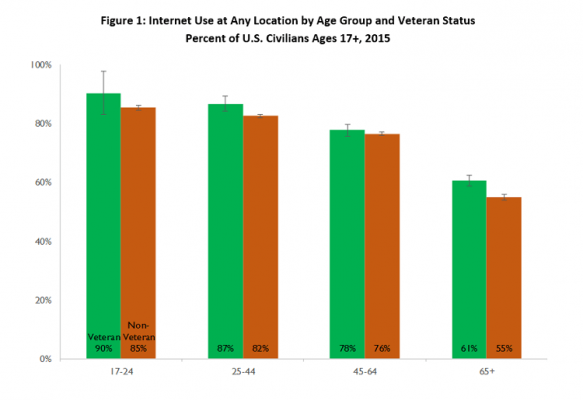By Giulia McHenry, Chief Economist, National Telecommunications and Information Administration (NTIA)
Broadband can play an essential role in supporting veterans by providing access to services and helping them to establish a stable and fulfilling civilian life.
As we honor our veterans this week, we take seriously our responsibility to ensure their seamless transition civilian life and recognize that it’s critical to that all veterans have access to broadband.
Understanding the barriers to veterans’ broadband access and adoption is the first step to reducing the challenges veterans face as they seek out job opportunities, affordable housing and vital health services.
In advance of Veterans Day, the National Telecommunications and Information Administration (NTIA) conducted an analysis of its Digital Nation data to better understand the landscape of veterans’ computer and internet use in America. Since 1994, NTIA has partnered with the U.S. Census Bureau to survey Americans about their computer and Internet use. Going all the way back to our earliest data collections, we broke out the data by veteran status and added “Veteran Status” as a search option in our Data Explorer tool – so that the public can more easily examine the data and create custom charts about internet use by veterans.
Veterans are demographically distinct from the overall U.S. population. The average age of veterans is 61, which is considerably older than non-veterans, with an average age of 45. Veterans are also more likely to live in rural areas and are more twice as likely to be disabled compared to the rest of the population. In addition, about half of veterans – 52 percent – are retired or not in the labor force. After accounting for demographic factors with known links to internet use, our analysis shows that veterans are 1 to 2 percent more likely to use the internet than non-veteran peers.
Age is among the most important demographic factors affecting internet use. When examining individual age groups, veterans are more likely than non-veterans in the same age group to use the internet. Since the military has been downsizing since around 1970, the veteran population is disproportionately older. This suggests that the rate of internet adoption among veterans is likely to increase over time.
Overall, when directly compared with the general U.S. population, veterans are slightly less likely to go online. However, this data point doesn’t tell the whole story – because factors such as older age, rural residence and having a disability are correlated with lower levels of internet use, independent of veteran status.
Additionally, veteran-led households that do not use the internet from home are more likely to say they do not need or are not interested in the service than non-veterans, and less likely to say they cannot afford it. This could be an indication that getting more veterans online will require a unique form of outreach and education. It is also consistent with the older age distribution of veterans compared with their peers.
NTIA’s most recent Digital Nation survey was conducted in July 2015, and the next survey goes into the field next week – with results available in the first half of 2018. Using a methodology recently outlined by NTIA staff, we expect to learn more about internet use among veterans by merging Digital Nation data with the CPS Veterans Supplement to examine how internet use relates to periods of service, service-connected disabilities, and participation in veteran-specific educational or job-training programs. NTIA’s data and research can serve as a vital resource for policymakers as they seek to understand the contours of the digital divide and increase internet access across the country.
Note: The survey identifies veterans as anyone who answers yes to the question “Did you ever serve on active duty in the U.S. armed forces?” This suggests that anyone who has completed basic military training would be considered a veteran. Since those currently on active duty are excluded from Census’ Current Population Survey (CPS), they are not included in the results of the survey. According to our data, veterans make up nearly 8 percent of the U.S. population aged 17 or older.
Interested in more analysis of computer and Internet use in the U.S.? Sign up for NTIA’s Data Central mailing list and be among the first to learn about future research and data releases.


